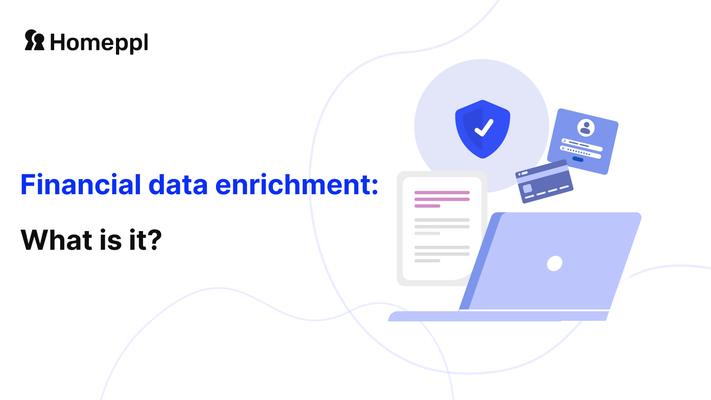Financial data enrichment is the process of adding additional further context or more-detailed information to pre-existing financial data. This can be done for a variety of purposes, such as improving the accuracy of financial analysis, enhancing the user experience of financial software, making better decisions when it comes to consumer risk assessment, to comply with international or local regulatory requirements that govern many fintechs and financial services today, or enabling new financial products and services.
In what ways can financial data be improved?
There are several ways that financial data can be augmented. One standard method combines financial data with external sources, such as news articles, social media posts, or publicly available databases. For example, a financial analysis tool might use data from a company's financial statements and data about the company's performance from publicly available news articles or company’s house information to provide a more complete picture of financial health.
Ways in which Homeppl utilises customer data enrichment
Homeppl’s full consumer risk qualification combines a number of data points on applicants to complete a full assessment for our clients. The data we collect includes financial, residential, identity, device, social and employment history data. Combining publicly available data, or data provided directly by the consumer can be used to formulate insightful risk modelling and affordability trends.
Another way to enrich financial data is by adding additional layers of data, such as geographical or demographic data, to the financial data. This can help to provide a more detailed understanding of the context of the original information and can again be used for further financial analysis and to make better-informed business decisions.

At Homeppl, our Enrichment product takes bank statements and financial documents provided by consumers and formulates a number of affordability insights based on the simple information provided solely within the statement. Our technology turns the banking account and transactional data from original bank statement PDFs and unifies them into standardised code. From that code, we can present graphs, insights, groupings and further financial data points relating to:
The financial health of a consumer
Daily spending habits
Any affiliation to gambling and/or nefarious companies and institutions
Overdraft usage
Payment anomalies
Number of income sources
Long and short-term affordability
These data points, presented instantaneously in a decision report, give our clients a much better understanding of consumer risk.
Data categorisation
The categorisation of that available data helps businesses go one step further in understanding the risk attached to each applicant.
It may be no help to a loan provider, when tasked with scanning three months worth of bank statements, to see that £2 was spent at Sainsbury's, £12 at Tesco, and 14 payments of varying amounts at Asda. But it will help the decision process when understanding that X amount of an applicant’s monthly income was spent on ‘groceries’, in comparison to X spent on ‘utilities’ and X on ‘gambling’. Enrichment provides value.
Importance of affordability assessments to the Financial Industry:
Data enrichment is important to the financial industry because it helps to improve the accuracy and usefulness of financial data. By adding additional context or information to financial data, analysts and decision-makers can make better-informed decisions about access to financial products, investments, and business strategies. Data enrichment can also enable the creation of new financial products and services by providing the necessary data to support them.
An example of how Homeppl have helped companies add new financial products to their offerings is through our guarantees. Due to our financial data management and analysis technology, we are able to more accurately determine the true affordability and risk of each consumer we approve.
These results are more detailed and accurate than that of standard Credit Reference Agencies (CRAs), which are still used by many financial firms. As we’re so confident in the accuracy of our decision, we can guarantee and assume the risk of all of our approvals. Lenders, banks, and letting agencies can sell these guarantees as an insurance-like product that protects assets and liabilities. The fact our guarantees are internationally accepted and claims are paid out the exact same day makes this financial product incredibly attractive as a bolt-on service.
What role does Open Banking play in the evolution of customer data enrichment?
Open banking plays a significant role in providing instant access to more precise financial data. What are Open banking algorithms? Open banking is a financial system in which banks make financial data available to third parties, such as fintech companies and other solution providers through APIs.
Companies like us, who use open banking algorithms, then present that data in the form of rich, value-added trends. We use open banking to help lenders and providers of financial products make better data decisions by providing a more complete and accurate picture of a financial situation. For example, if you are considering investing in a company, data enrichment can help you to better understand the company's financial health by combining financial data with alternative data sources. This can help you to make more informed investment decisions. If you are a lender and you’re presented with 1,000 applications for a personal loan, financial data analysis and enrichment can help assess and rank the risk and affordability of each applicant and in turn help businesses thrive by determining a profitable risk appetite.
How B2B data enrichment tools help banks?
Payments data enrichment is important to banking because it can help to improve the accuracy and efficiency of payment processing. By enriching payments data with additional information, banks can more easily identify fraudulent activity, reduce errors, and improve the overall experience of using payment services.
Both traditional banks, who have been somewhat hesitant about technological advancements available for improving operational efficiency, and challenger banks (often start-ups) that rely on manual processes can benefit tremendously from the automation that goes hand-in-hand with enrichment.
Financial data enrichment now works off algorithms and is both accurate and instantaneous. Human errors in checking affordability and performing calculations are inevitable at scale. Algorithms reduce the loss caused by human error. They also speed up operations by cutting the need for tedious manual tasks. Companies can spend hundreds of unnecessary hours reviewing applications for example. Automated financial risk assessment reduces these costs significantly.
Financial data is often neglected, but it can hold the answers to critical questions about creditworthiness. We develop custom solutions that enrich financial data by revealing the true picture of an applicant’s financial behaviour, risk, and affordability. In the current economic climate, important decisions pertaining to financial access should be made based on the most precise data available.
Discover more about Homeppl's enrichment tool >
What to read next:
The rising threat of fraud in the insurance sector
The Top Ways Mortgage Lenders Verify Bank Statements
How KYC Assessments can be enhanced with Document Verification
Risk management for Fintechs: Build a strong framework in the consumer loans space




